Paintings often have symbols within their composition, whether this is the metaphor of a wilting rose or a bold reference to classical mythology. Some of the most complex and interesting symbols can be found in the depiction of Christian saints, where many pieces may appear to be inaccessible unless you have a prior understanding of their signs and backstory. This article will explore some of the most frequently depicted saints in Christian art and how to interpret them.
 Above: Saints Bartholomew, Saint Andrew and Saint Thomas, 14th century
Above: Saints Bartholomew, Saint Andrew and Saint Thomas, 14th century
The Apostles
St Matthew: often seen with an angel, winged man or writing the gospel, Matthew was originally a tax collector who was called upon by Jesus – this can be seen in a painting by Caravaggio from 1599. Matthew was one of the witnesses of the ascension of Jesus so may be included in these scenes.
St Mark: usually found writing or holding his gospel (often entitled pax tibi Marce) and with the symbol of a winged lion or a lion in the desert. Mark is sometimes shown rescuing sailors or Christian slaves from the Saracens.
 Above: engravings of the four evangelists Matthew, Mark, Luke and John, 1518
Above: engravings of the four evangelists Matthew, Mark, Luke and John, 1518
St Luke: a winged bull or ox is the symbol of Luke and like the other evangelists he may be seen writing or holding his gospel. Christian tradition views Luke as the first painter of icons, he is said to have painted the Virgin Mary, Christ child, Peter and Paul – so you may see him depicted as an artist at his easel in the company of the Virgin Mary.
St John: often seen with an eagle or a chalice (sometimes with a snake inside), John the evangelist can be depicted in his youth or as an elderly, bearded man. The youthful image of John can appear almost feminine due to his affective piety. Like the other evangelists, he may also be found writing or holding his gospel.
 Above: a stained glass window of Saint Peter (1520) and a mezzotint of Saint Jude (1750)
Above: a stained glass window of Saint Peter (1520) and a mezzotint of Saint Jude (1750)
St Peter: usually an older bearded man, Peter holds one or two large keys as the keeper of the gates of heaven. In group paintings he is often standing the closest to Christ or as a fisherman. Peter was crucified upside down, this scene or imagery from his imprisonment may also be depicted in paintings. As the first leader of the church, he may also be seen in the role of a pope or bishop. A rooster may also be seen with Peter in reference to him ‘denying Christ three times before the cockerel crows twice’.
St Jude: this saint can be seen with a sword, a club, a ship, a square carpenter’s ruler or holding a book (Epistle of Jude). Jude may also be holding an image of Jesus to his chest or with a flame above his head to symbolise the pentecost.
 Above: a sculpture and drawing of Saint Andrew and an engraving and sculpture of Saint Philip
Above: a sculpture and drawing of Saint Andrew and an engraving and sculpture of Saint Philip
St Andrew: with a fish or rope, or St Andrews Cross – this cross is the same X shape as the way he was crucified.
St Philip: depicted with a basket of loaves or a column, Philip may also be shown with the Tau Cross (a T-shaped cross with no upper half, also known as Saint Anthony’s cross). He may also be seen with a spear that holds the patriarchal cross or a cross with a square carpenter’s ruler. Along with Bartholomew, Philip was crucified upside down, so he may also be seen with a cross or a cross on its side.
 Above: an engraving of St Simon by Dürer (1523), a statue of St James the Greater (1560) and a neo-byzantine icon of St James the Just
Above: an engraving of St Simon by Dürer (1523), a statue of St James the Greater (1560) and a neo-byzantine icon of St James the Just
St Simon: seen with a boat, an oar, or fish. Simon is traditionally seen with a saw, as he was martyred by being longitudinally sawn in half.
St James the Greater (son of Zebedee): a pilgrim staff or hat, a sword, a key or the cross of Saint James can all be seen in typical depictions. The scallop shell is also symbolic of pilgrimage due to its association with St James, who is also the patron saint of Spain.
St James the Just (son of Alphaeus): a saw or a square ruler, a club or a long axe known as a halberd. He may also be holding a book. He may be wearing white robes with a black cross.
 Above: a statue of Saint Bartholomew (16th or 17th century), an engrvaing of Saint Thomas (1510) and a wooden sculpture depicting The Kiss of Judas (16th century)
Above: a statue of Saint Bartholomew (16th or 17th century), an engrvaing of Saint Thomas (1510) and a wooden sculpture depicting The Kiss of Judas (16th century)
St Bartholomew: often holding a knife or his own skin in reference to his martyrdom. Figures around him may also be holding the flaying knife in reference to what is about to occur.
St Thomas: with carpentry tools, an axe or spear, or with his finger in the side of Christ as a reference to a scene from the resurrection. He may also be seen with a lotus flower due to his association with Indian Christianity.
Judas Iscariot: often seen with the thirty pieces of silver he was granted for betraying Christ. In groups, he is often the only apostle without a halo, or with a dark halo instead of a bright one. He is sometimes seen kissing Christ as part of the betrayal story and may be wearing yellow.
 Above: a detail from The Last Supper by Ugolino da Siena (1325-30) showing Judas as the only apostle without a halo
Above: a detail from The Last Supper by Ugolino da Siena (1325-30) showing Judas as the only apostle without a halo
Female Saints
St Anne (mother of the Virgin Mary): with a book, a door, dressed in red and green, she may also be holding the infant Christ or with the Virgin Mary reading.
 Above: left and right – a statue of Saint Anne holding the Virgin Mary and Christ child (1500), centre – a panel painting of Saint Anne (1479–82)
Above: left and right – a statue of Saint Anne holding the Virgin Mary and Christ child (1500), centre – a panel painting of Saint Anne (1479–82)
St Cecilia: the patron saint of music, she may be seen playing an instrument whilst looking towards heaven, usually an organ or strings. Depictions of Cecilia may also include a palm leaf or a sword, as well as roses and lilies.
 Above: an engraving of Saint Cecilia (1640-59) and an oil on canvas by Abraham van Diepenbeeck (17th century)
Above: an engraving of Saint Cecilia (1640-59) and an oil on canvas by Abraham van Diepenbeeck (17th century)
St Lucy: holding her eyes on a plate, a lamp or a sword. She is associated with other female virgin martyrs, particularly St Agatha.
 Above: a painting of Saint Lucy holding her eyes on a plate (18th century)
Above: a painting of Saint Lucy holding her eyes on a plate (18th century)
St. Margaret of Antioch: a slain dragon or demon, a hammer, or a shepherd’s crook -sometimes with the shape of the cross on the end.
 Above: an alabaster and wooden sculpture of Saint Magaret (1470s) and a maiolica plate (1527)
Above: an alabaster and wooden sculpture of Saint Magaret (1470s) and a maiolica plate (1527)
St Agatha: with tongs, bells, shears or her breasts on a plate in reference to her martyrdom.
 Above: a depiction of Saint Agatha holding her breasts on a plate, 1470
Above: a depiction of Saint Agatha holding her breasts on a plate, 1470
St Catherine of Alexandria: with a wheel (either full or in fragments) in reference to her martyrdom. Catherine is also seen in scenes of a mystic marriage to Jesus, she can be depicted receiving a ring from infant Christ in heaven.
 Above: a bejewelled statuette (15th century) and marble statue (1514-24) of Saint Catherine and a painting of Saint Catherine’s mystic marriage to Christ by Jusepe de Ribera (1648)
Above: a bejewelled statuette (15th century) and marble statue (1514-24) of Saint Catherine and a painting of Saint Catherine’s mystic marriage to Christ by Jusepe de Ribera (1648)
St Joan (Joan of Arc): usually depicted with a sword, wearing a suit of armour or as a peasant girl.
 Above: a plate with Joan of Arc (1878) and an oil painting by George William Joy (1895)
Above: a plate with Joan of Arc (1878) and an oil painting by George William Joy (1895)
St Agnes: a young girl with a lamb, often wearing her hair down due to her age.
 Above: depictions of Saint Agnes in an engraving (1631), a woodcut (1512), stained glass (1490) and painted alabaster (16th century)
Above: depictions of Saint Agnes in an engraving (1631), a woodcut (1512), stained glass (1490) and painted alabaster (16th century)
St Ursula: holding a flag, shielding women under her cloak, or an arrow as she was martyred with an arrow to her neck, this may still be in place or her neck may show a wound. Ursula died alongside 11,000 maidens, so may be shown surrounded by this event. Legend states that Ursula was a princess, so she is often shown with a crown or coronet.
 Above: a detail from a painting of Saint Ursula surrounded by her maidens (1410)
Above: a detail from a painting of Saint Ursula surrounded by her maidens (1410)
St Veronica: usually holding a cloth depicting the face of Christ, known as the veil of Veronica.
 Above: various depictions of Saint Veronica including a tapestry (1525), painting by Hans Memling (1470) and an engraving (1435-90)
Above: various depictions of Saint Veronica including a tapestry (1525), painting by Hans Memling (1470) and an engraving (1435-90)
Other Christian images & colour symbolism
There are many other symbols in Christian art that you may come across, these include:
Dove: symbolising peace and baptism.
Pelican: the passion of Jesus and the eucharist, due to the story of a pelican wounding itself to feed its young if no other food was available.
Anchor: hope, steadfastness and safety.
 Above: an engraving with the holy dove (1534), a brass plate with a pious pelican (1600s) and an engraving of hope standing above an anchor (1648-56)
Above: an engraving with the holy dove (1534), a brass plate with a pious pelican (1600s) and an engraving of hope standing above an anchor (1648-56)
Peacock: a sign of immorality due to a legend that a peafowl’s body did not decay, it may also reference resurrection.
Fire: the holy spirit, the light of Christ or the light of the world.
Shamrock: the symbol of St Patrick depicting the holy trinity.
 Above: a detail from Virgin and Child by Bernard van Orley featuring peacocks (1518)
Above: a detail from Virgin and Child by Bernard van Orley featuring peacocks (1518)
Eye in a triangle: this is the eye of providence, the triangle symbolises the holy trinity surrounding the eye of god, who is shown to be omnipresent.
Lily: purity, the Virgin Mary, sometimes as a lily crucifix combining them due to the belief that the annunciation and crucifixion both happened on the same day of the year.
Red: the Pentecost, the blood of Christ, saints who were martyrs, spiritual awakening.
 Above: The Annunciation by Luca Giordano (1672) featuring lilies, Supper at Emmaus by Pontormo (1525) featuring the eye of providence, and Saint Barbara by Lucas Cranach the Elder (1510) featuring red robes to represent her martyrdom
Above: The Annunciation by Luca Giordano (1672) featuring lilies, Supper at Emmaus by Pontormo (1525) featuring the eye of providence, and Saint Barbara by Lucas Cranach the Elder (1510) featuring red robes to represent her martyrdom
White: the Virgin Mary, purity, saints who were not martyrs.
Purple: lent and advent, wealth, it is also a mixture of red and blue representing the status of Christ – red representing mankind and blue for heaven or divinity.
 Above: a detail from The Departure of Saints Paula and Eustochium by Giuseppe Bottani (18th century) featuring white robes because these saints were not martyrs
Above: a detail from The Departure of Saints Paula and Eustochium by Giuseppe Bottani (18th century) featuring white robes because these saints were not martyrs
Saint painting conservation and restoration
Our studio often receives Christian art in need of conservation treatment due to their old age or exposure to airborne contaminants (such as smoke and soot). Our conservators have worked on large oil paintings and small icons on wooden panel, including those with gold leaf details and challenging levels of damage.
 Above: details from the cleaning of two altarpiece paintings for Farnborough abbey showing surface discolouration
Above: details from the cleaning of two altarpiece paintings for Farnborough abbey showing surface discolouration
The most common issues facing religious art come from the environments they have been kept in, we find that paintings from churches may have built up historic dust and debris and become severely discoloured over time. This hides the bright colours and the importance of the visual impact upon the viewer. A recent restoration in our studio was for Farnborough Abbey, two 14ft altarpiece paintings and their ornate frames required a sensitive cleaning due to historic contamination. You can read more about this process and the stories behind the paintings here.
 Above: a church painting with a tear, before and after restoration in our studio
Above: a church painting with a tear, before and after restoration in our studio
Wooden icons of saints face their own challenges due to the possibility of a woodworm infestation or material deterioration causing deep cracks or full breakages. Our conservators stabilize wooden panels and safely seal any holes from woodworm to ensure they do not return. Historic varnish may have also discoloured over time, this can be removed and replaced with a new, conservation-safe variety that is not known to yellow or darken in the same way.
![]()
How can we help?
Our team is always happy to help you find out more about your painting, as well as arrange for routine care or restoration work following damage. Please email us via [email protected] or call 0207 112 7576

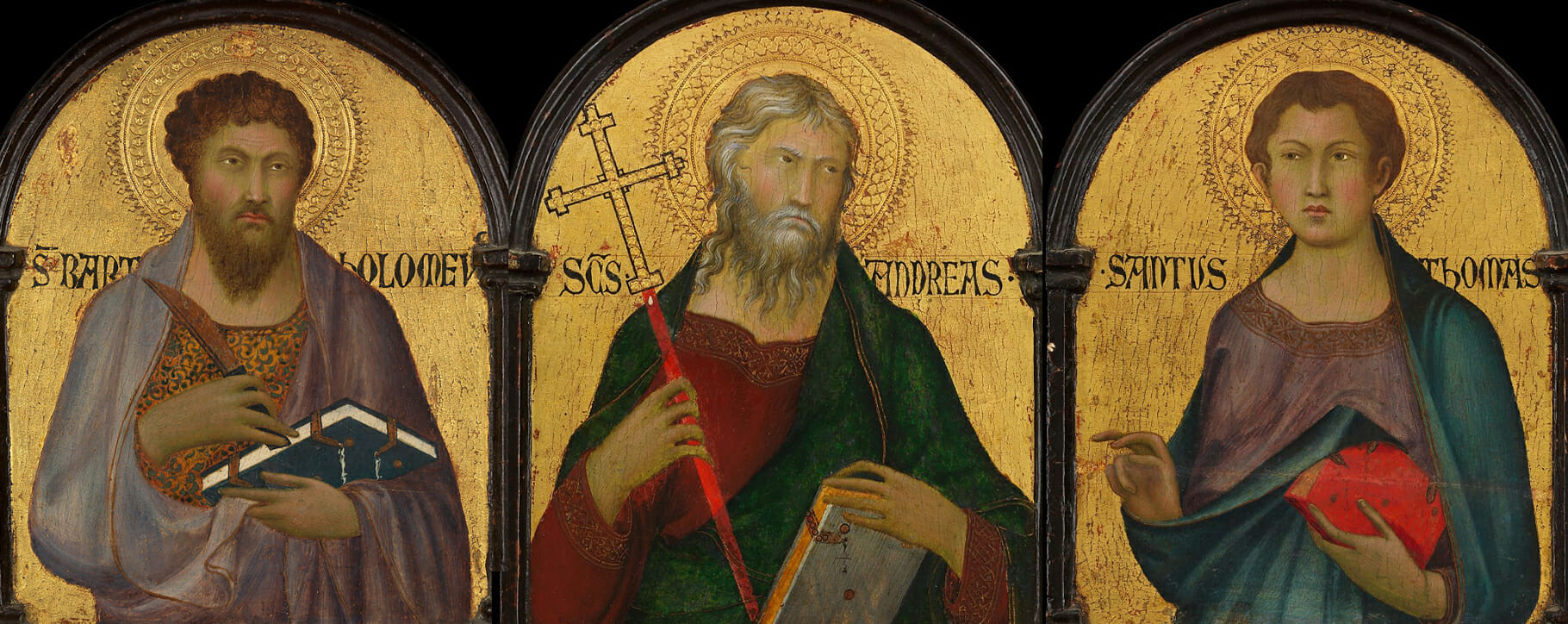 Above: Saints Bartholomew, Saint Andrew and Saint Thomas, 14th century
Above: Saints Bartholomew, Saint Andrew and Saint Thomas, 14th century Above: engravings of the four evangelists Matthew, Mark, Luke and John, 1518
Above: engravings of the four evangelists Matthew, Mark, Luke and John, 1518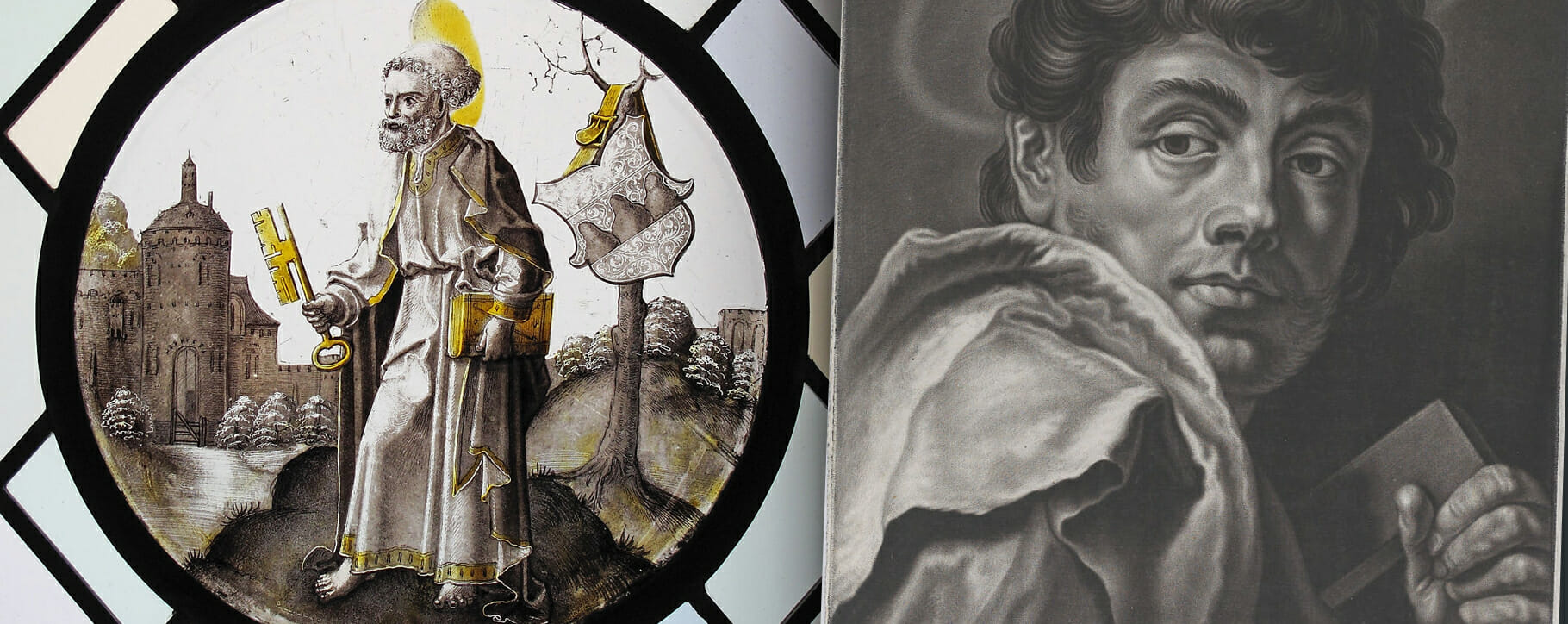 Above: a stained glass window of Saint Peter (1520) and a mezzotint of Saint Jude (1750)
Above: a stained glass window of Saint Peter (1520) and a mezzotint of Saint Jude (1750)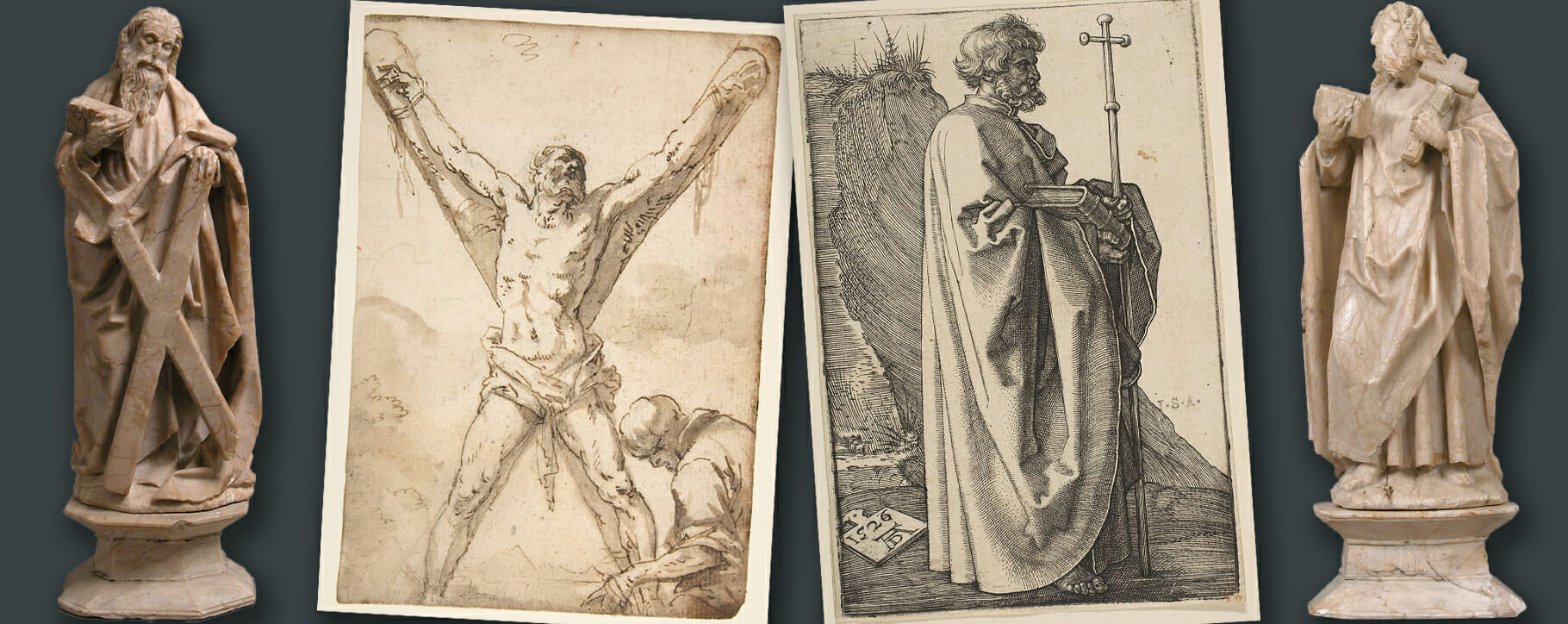 Above: a sculpture and drawing of Saint Andrew and an engraving and sculpture of Saint Philip
Above: a sculpture and drawing of Saint Andrew and an engraving and sculpture of Saint Philip Above: an engraving of St Simon by Dürer (1523), a statue of St James the Greater (1560) and a neo-byzantine icon of St James the Just
Above: an engraving of St Simon by Dürer (1523), a statue of St James the Greater (1560) and a neo-byzantine icon of St James the Just  Above: a statue of Saint Bartholomew (16th or 17th century), an engrvaing of Saint Thomas (1510) and a wooden sculpture depicting The Kiss of Judas (16th century)
Above: a statue of Saint Bartholomew (16th or 17th century), an engrvaing of Saint Thomas (1510) and a wooden sculpture depicting The Kiss of Judas (16th century)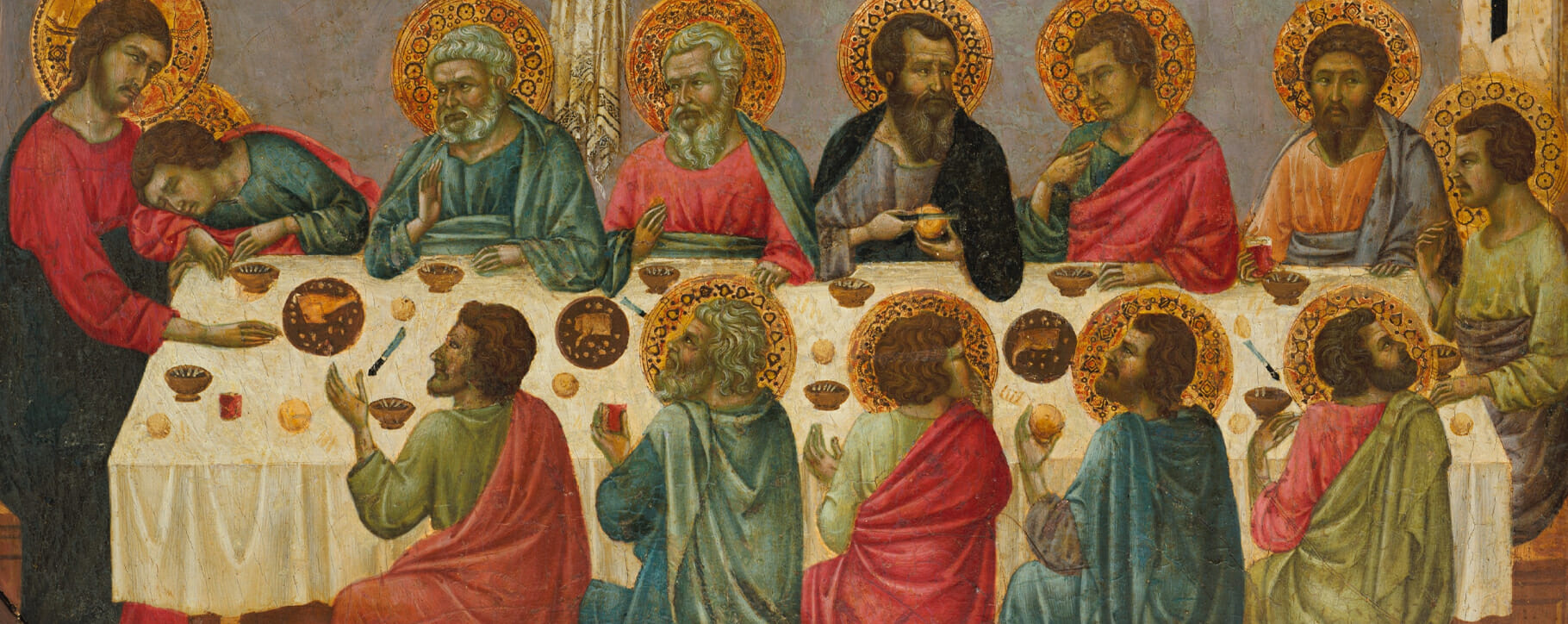 Above: a detail from The Last Supper by Ugolino da Siena (1325-30) showing Judas as the only apostle without a halo
Above: a detail from The Last Supper by Ugolino da Siena (1325-30) showing Judas as the only apostle without a halo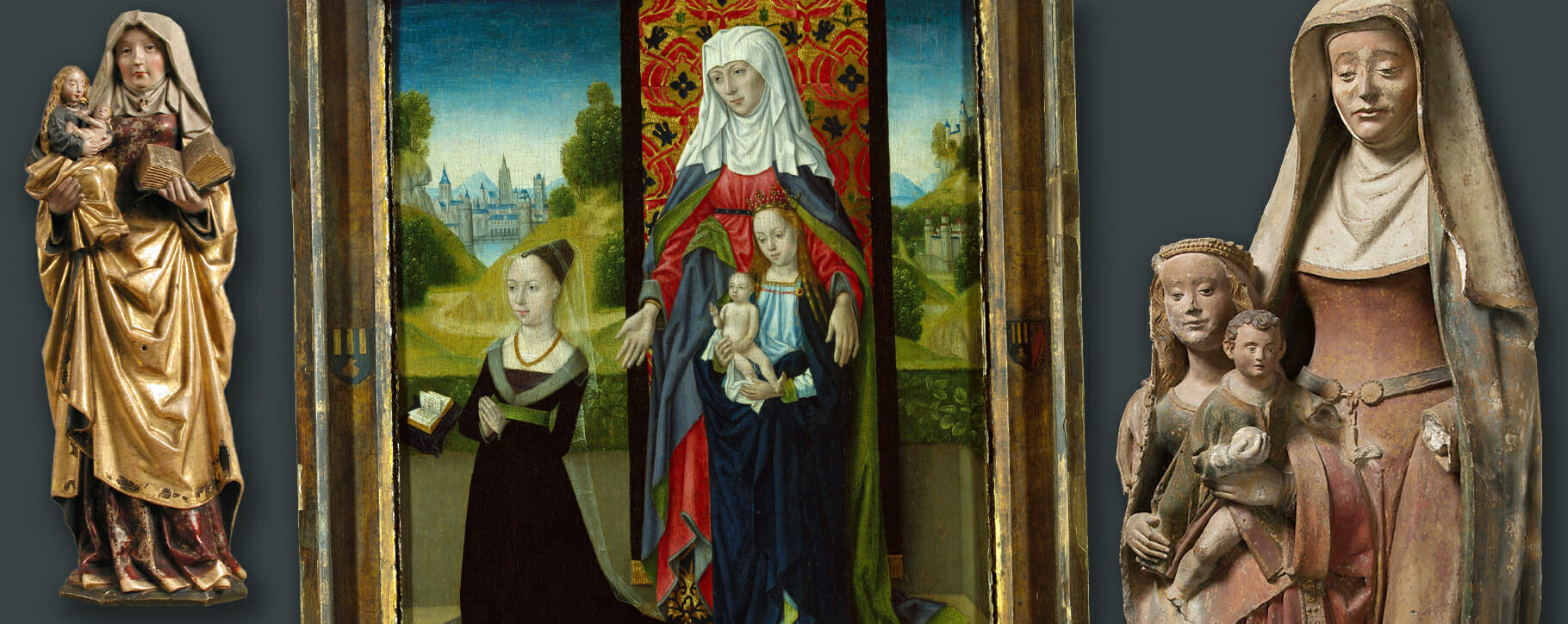 Above: left and right – a statue of Saint Anne holding the Virgin Mary and Christ child (1500), centre – a panel painting of Saint Anne (1479–82)
Above: left and right – a statue of Saint Anne holding the Virgin Mary and Christ child (1500), centre – a panel painting of Saint Anne (1479–82)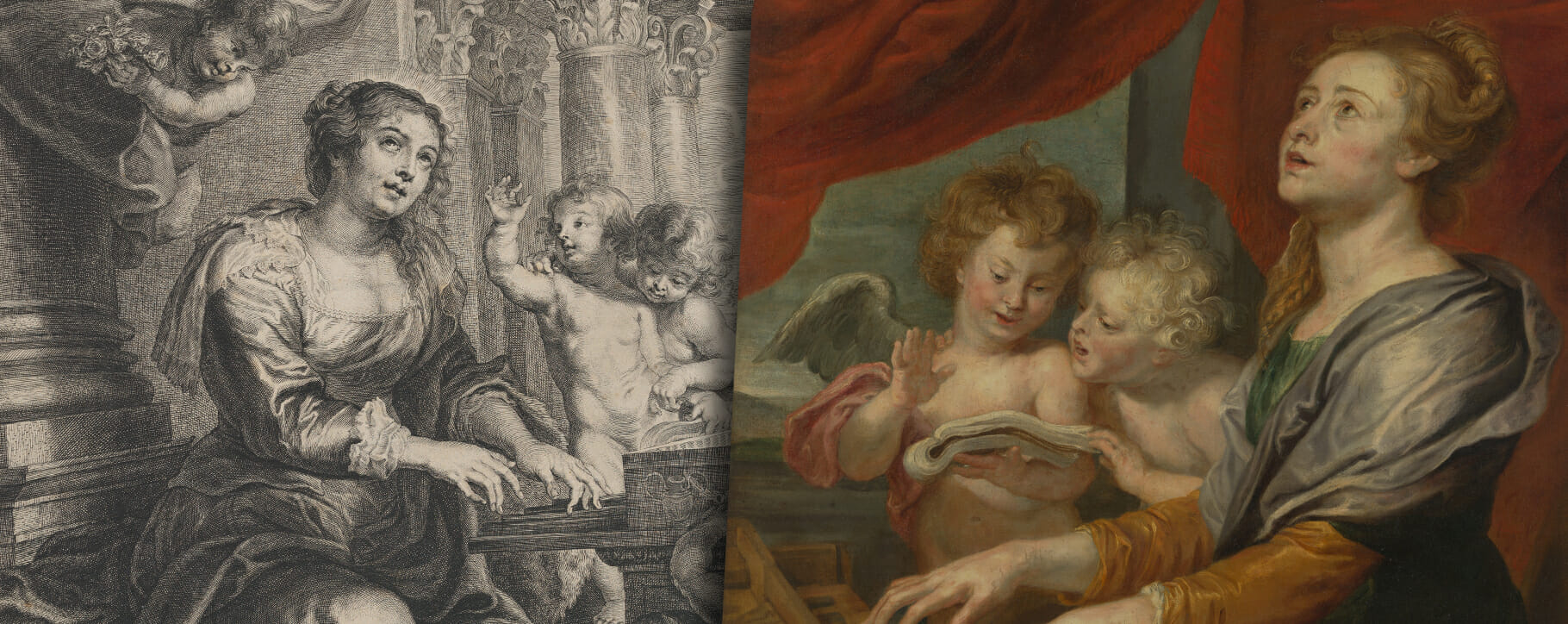 Above: an engraving of Saint Cecilia (1640-59) and an oil on canvas by Abraham van Diepenbeeck (17th century)
Above: an engraving of Saint Cecilia (1640-59) and an oil on canvas by Abraham van Diepenbeeck (17th century) Above: a painting of Saint Lucy holding her eyes on a plate (18th century)
Above: a painting of Saint Lucy holding her eyes on a plate (18th century)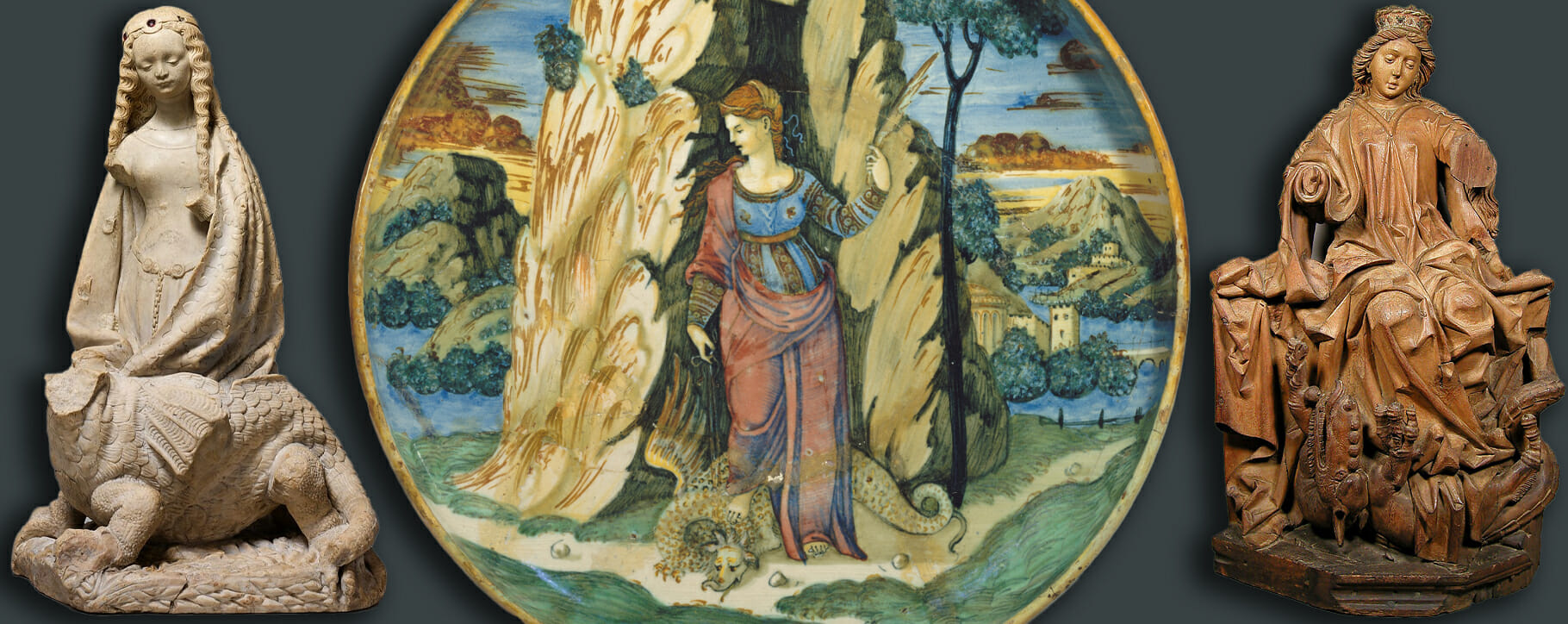 Above: an alabaster and wooden sculpture of Saint Magaret (1470s) and a maiolica plate (1527)
Above: an alabaster and wooden sculpture of Saint Magaret (1470s) and a maiolica plate (1527)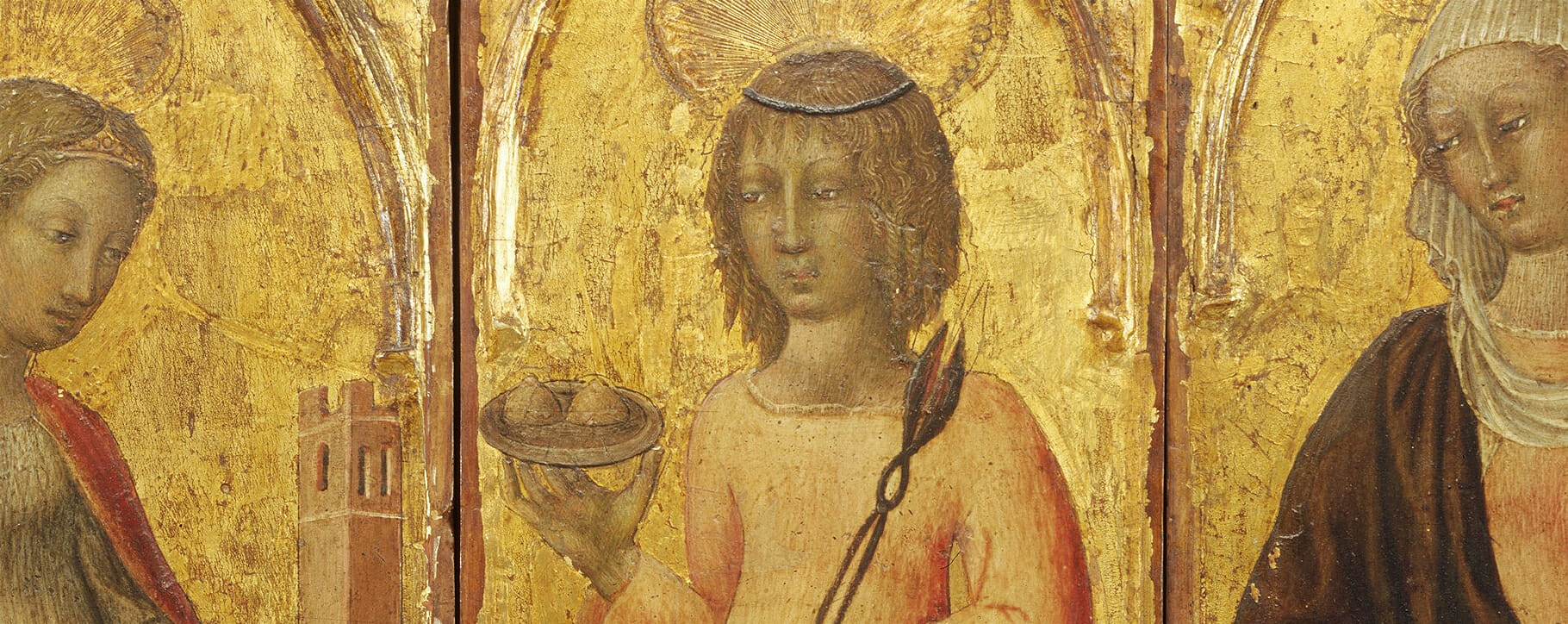 Above: a depiction of Saint Agatha holding her breasts on a plate, 1470
Above: a depiction of Saint Agatha holding her breasts on a plate, 1470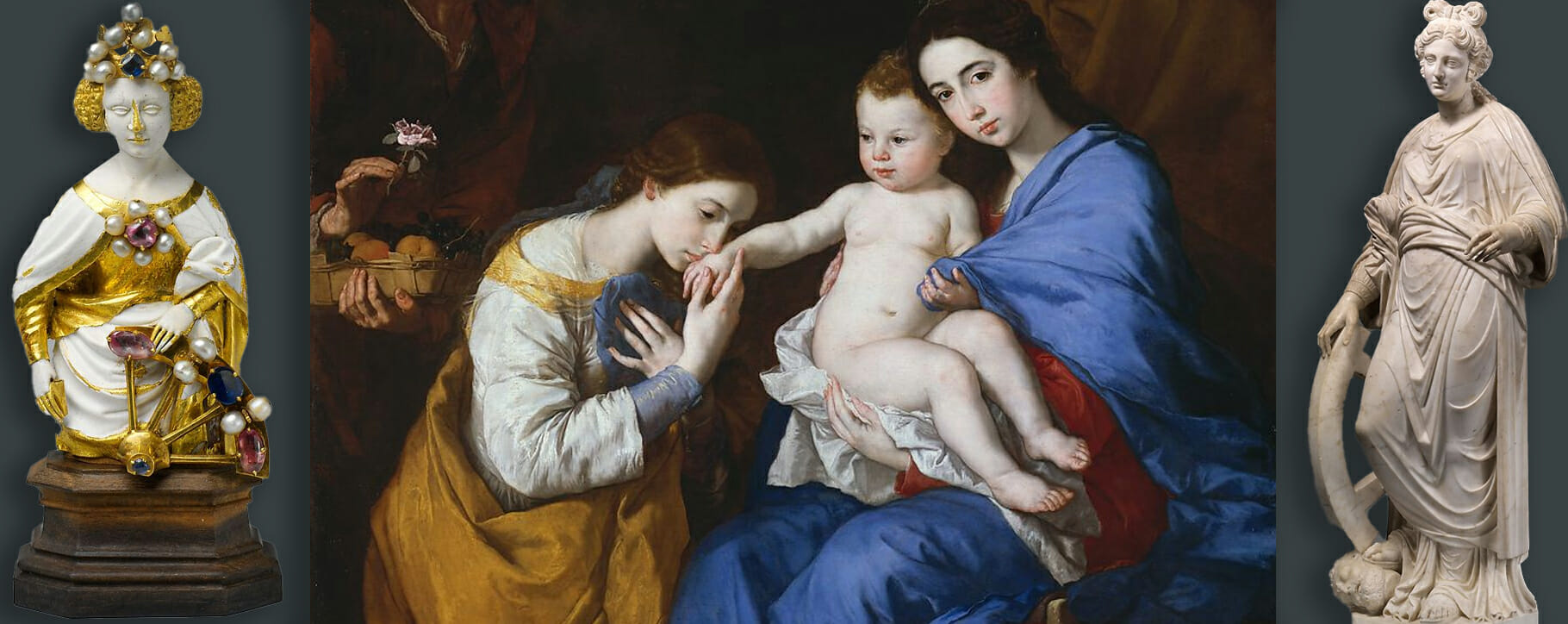 Above: a bejewelled statuette (15th century) and marble statue (1514-24) of Saint Catherine and a painting of Saint Catherine’s mystic marriage to Christ by Jusepe de Ribera (1648)
Above: a bejewelled statuette (15th century) and marble statue (1514-24) of Saint Catherine and a painting of Saint Catherine’s mystic marriage to Christ by Jusepe de Ribera (1648)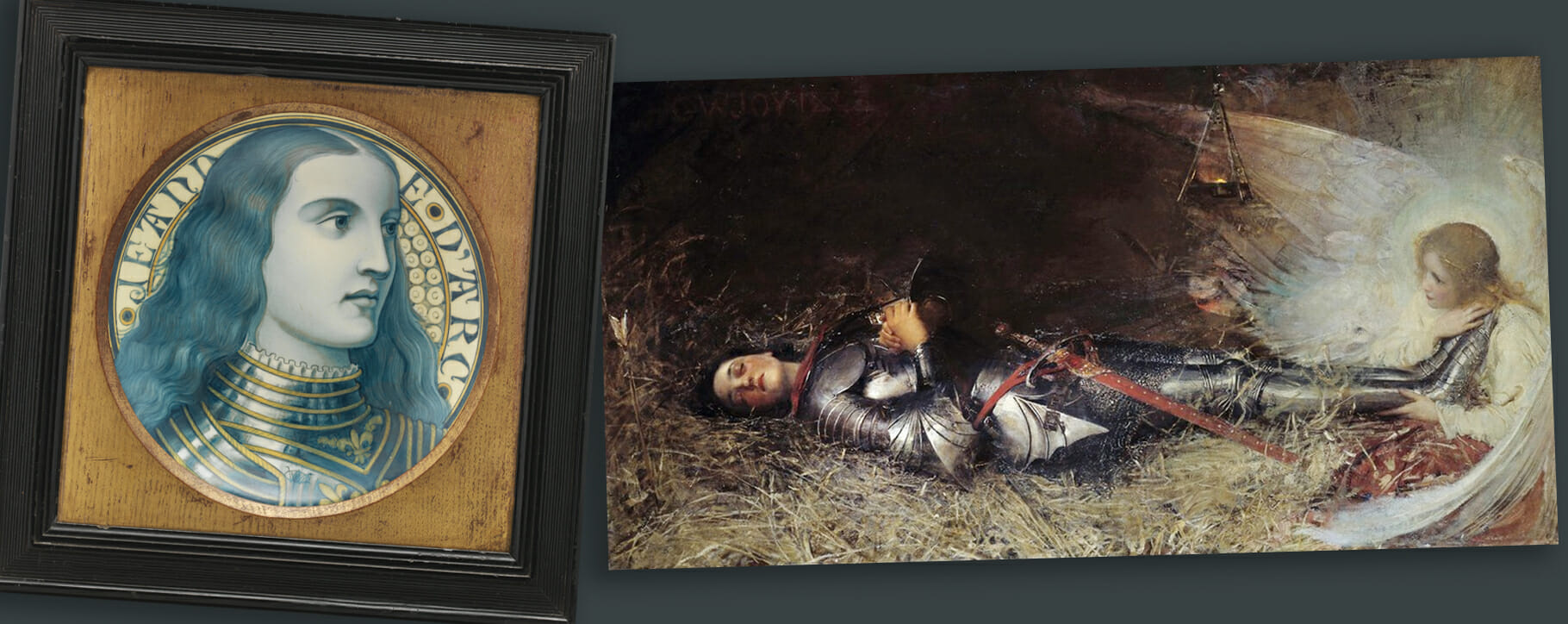 Above: a plate with Joan of Arc (1878) and an oil painting by George William Joy (1895)
Above: a plate with Joan of Arc (1878) and an oil painting by George William Joy (1895)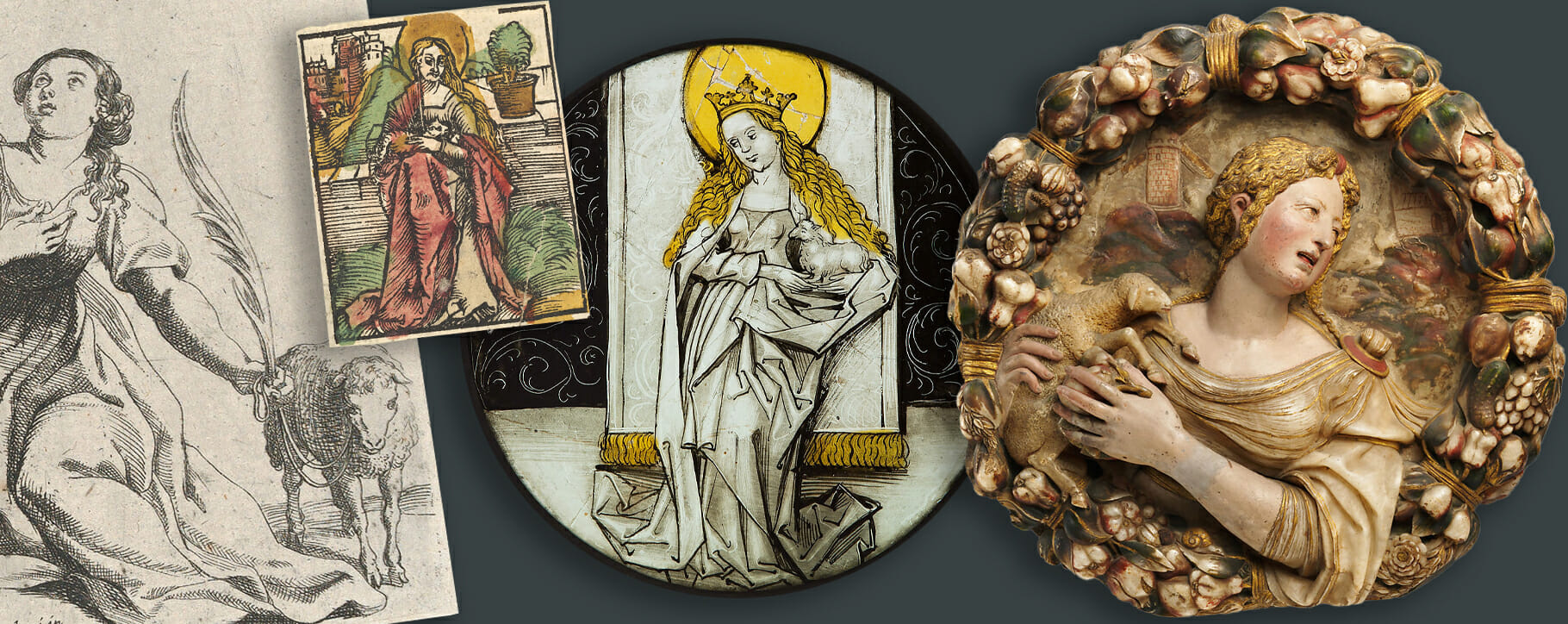 Above: depictions of Saint Agnes in an engraving (1631), a woodcut (1512), stained glass (1490) and painted alabaster (16th century)
Above: depictions of Saint Agnes in an engraving (1631), a woodcut (1512), stained glass (1490) and painted alabaster (16th century) Above: a detail from a painting of Saint Ursula surrounded by her maidens (1410)
Above: a detail from a painting of Saint Ursula surrounded by her maidens (1410)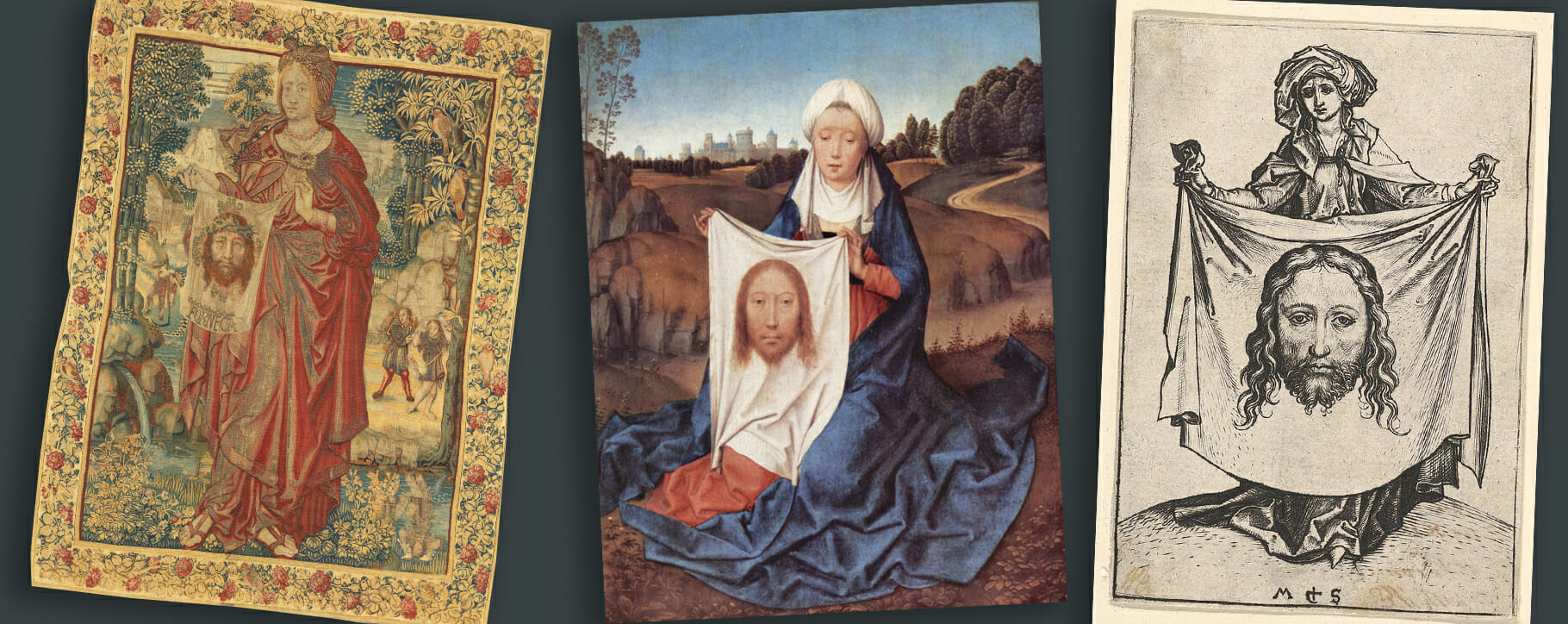 Above: various depictions of Saint Veronica including a tapestry (1525), painting by Hans Memling (1470) and an engraving (1435-90)
Above: various depictions of Saint Veronica including a tapestry (1525), painting by Hans Memling (1470) and an engraving (1435-90) Above: an engraving with the holy dove (1534), a brass plate with a pious pelican (1600s) and an engraving of hope standing above an anchor (1648-56)
Above: an engraving with the holy dove (1534), a brass plate with a pious pelican (1600s) and an engraving of hope standing above an anchor (1648-56)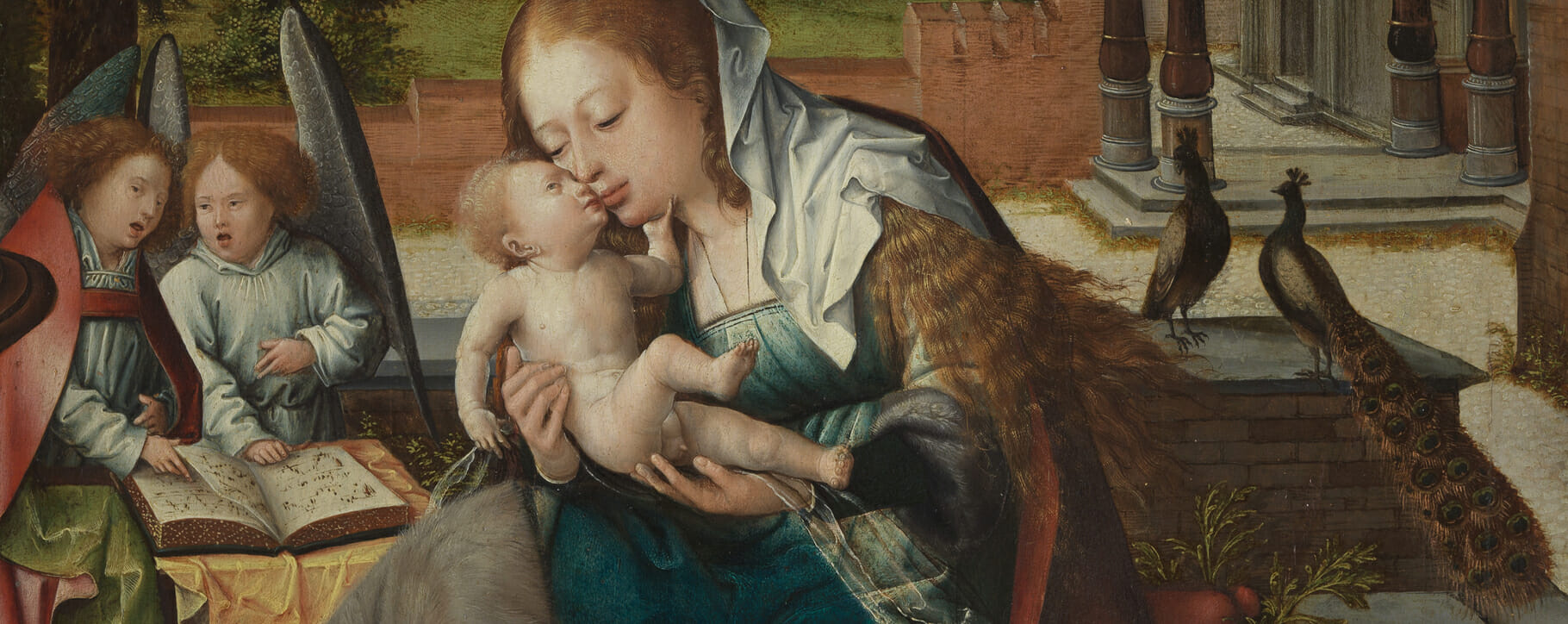 Above: a detail from Virgin and Child by Bernard van Orley featuring peacocks (1518)
Above: a detail from Virgin and Child by Bernard van Orley featuring peacocks (1518)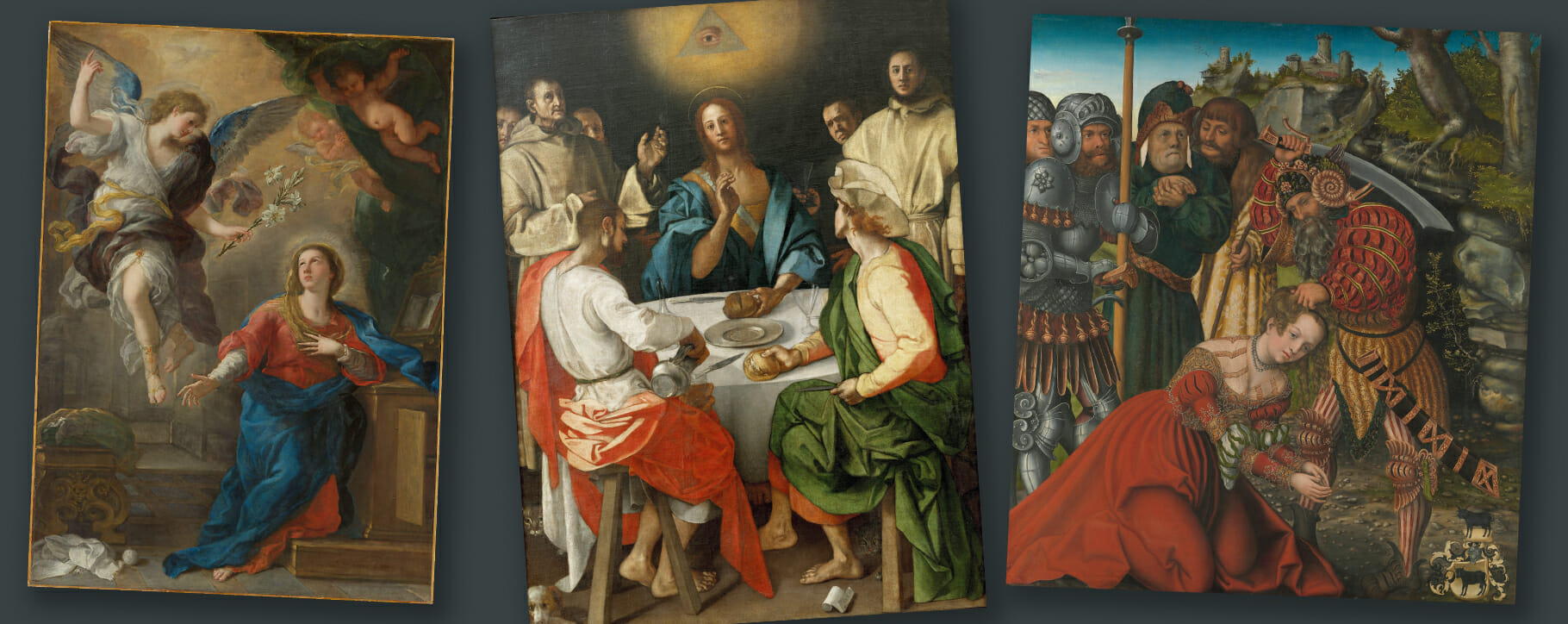 Above: The Annunciation by Luca Giordano (1672) featuring lilies, Supper at Emmaus by Pontormo (1525) featuring the eye of providence, and Saint Barbara by Lucas Cranach the Elder (1510) featuring red robes to represent her martyrdom
Above: The Annunciation by Luca Giordano (1672) featuring lilies, Supper at Emmaus by Pontormo (1525) featuring the eye of providence, and Saint Barbara by Lucas Cranach the Elder (1510) featuring red robes to represent her martyrdom  Above: a detail from The Departure of Saints Paula and Eustochium by Giuseppe Bottani (18th century) featuring white robes because these saints were not martyrs
Above: a detail from The Departure of Saints Paula and Eustochium by Giuseppe Bottani (18th century) featuring white robes because these saints were not martyrs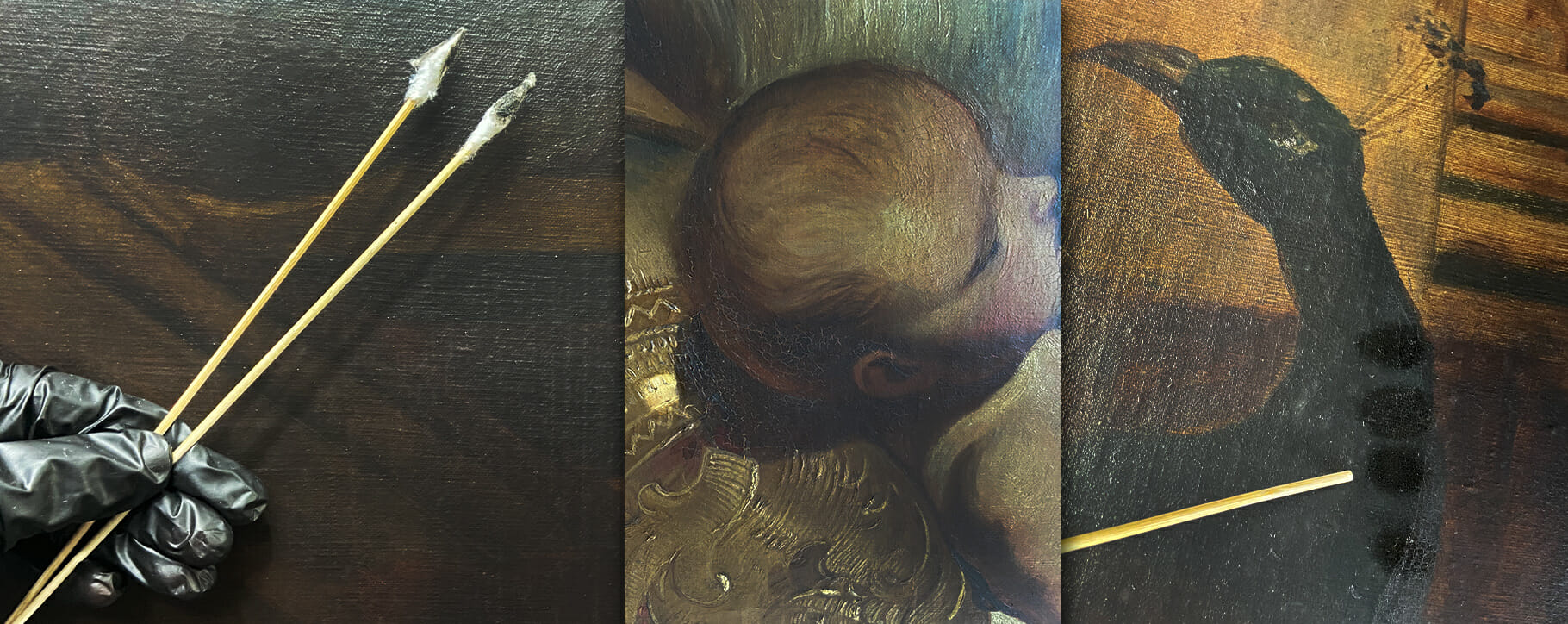 Above: details from the cleaning of two altarpiece paintings for Farnborough abbey showing surface discolouration
Above: details from the cleaning of two altarpiece paintings for Farnborough abbey showing surface discolouration 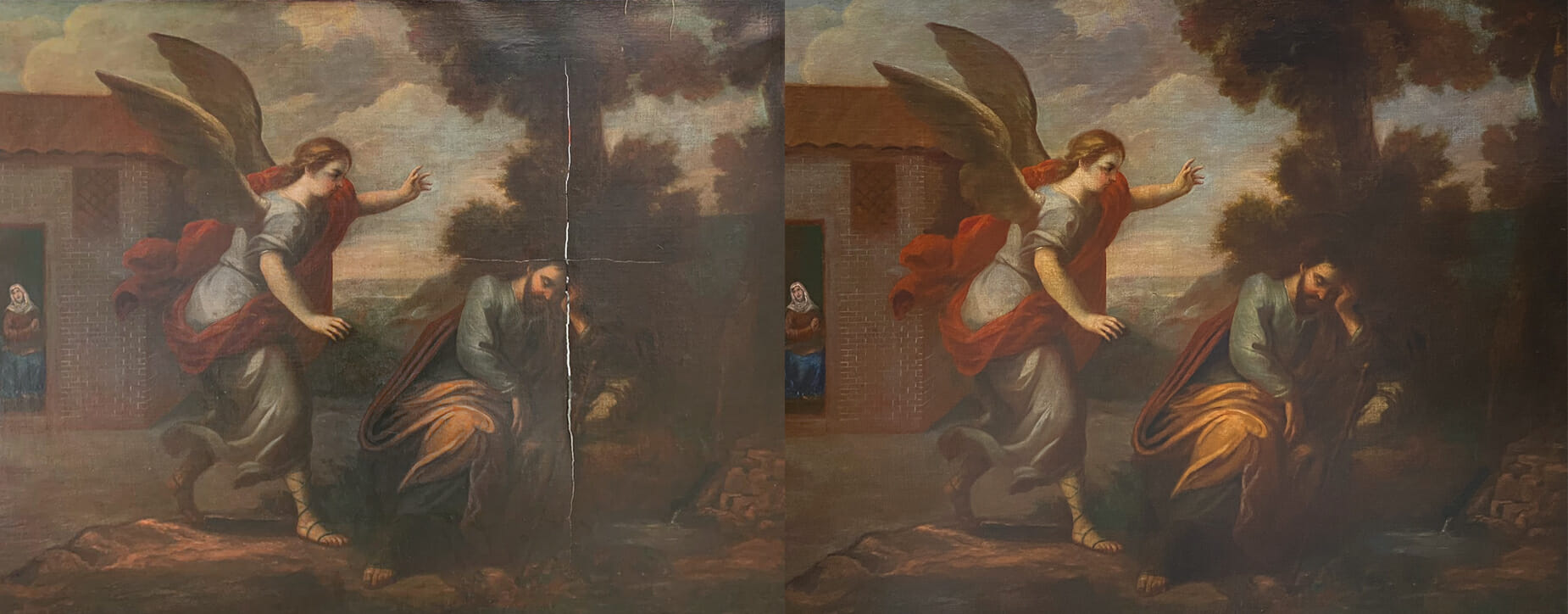 Above: a church painting with a tear, before and after restoration in our studio
Above: a church painting with a tear, before and after restoration in our studio




